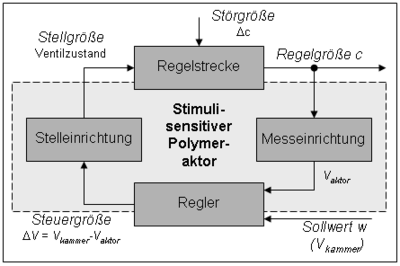Chemostat valve
A chemostat valve is a control circuit which , depending on the concentration of a certain substance, restricts or increases the supply of a medium via a valve in order to keep the concentration of this or a substance dependent on it constant. Chemostat valves are made possible by functional elements based on stimuli-sensitive polymers .
Structure of a chemostat valve control circuit
The chemostat is used to bring a substance or ion concentration ( controlled variable c) to a target value w and to keep it constant. The measuring device for the actual value is stimuli-sensitive polymers that have the peculiarity of permanently adapting their volume to the actual value of the concentration. If the actual value corresponds to the setpoint value (c = w), the difference, serving as a control variable, between the volumes of the actuator chamber Vkammer serving as a valve seat and the polymer actuator Vaktor is equal to zero. If the actual value deviates from the setpoint value (c ≠ w), the control variable ΔV becomes greater than zero, as a result of which the valve state changes in such a way that the control variable c reduces the deviation from the setpoint w again or completely eliminates it. An intervention by the controller is triggered either by the user changing the target value (concentration selection) or by a fault. A disorder is usually a change in concentration as a result of consumption or synthesis or enrichment. It is called the disturbance variable (Δc).
The controller comprises the actuator chamber and the polymer actuator. In the simplest case, the control point can take place by mechanically changing the actuator chamber volume V chamber , since the setting condition V chamber = V actuator , with exactly one concentration c being assigned to each actuator volume based on its sensory properties. Another possibility for setting the chemostat control point is by shifting the actuator characteristic by utilizing a double sensitivity of the stimuli-sensitive polymer.
Controllable concentrations
The following substance concentrations in aqueous media have so far been able to be controlled with a chemostat:
Individual evidence
- ^ Journal article Sens. Actuat. B 2007 , 125 , pp. 569-573. doi: 10.1016 / j.snb.2007.03.002
- ^ Journal article Adv Mater . 2007 , 19 , pp. 1109-1112. doi: 10.1002 / adma.200601989

